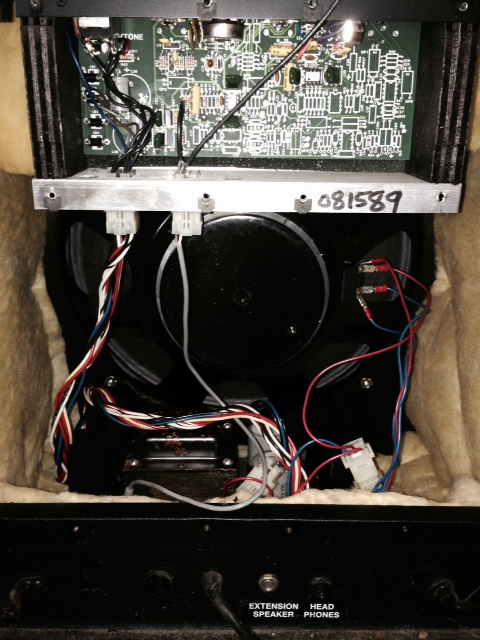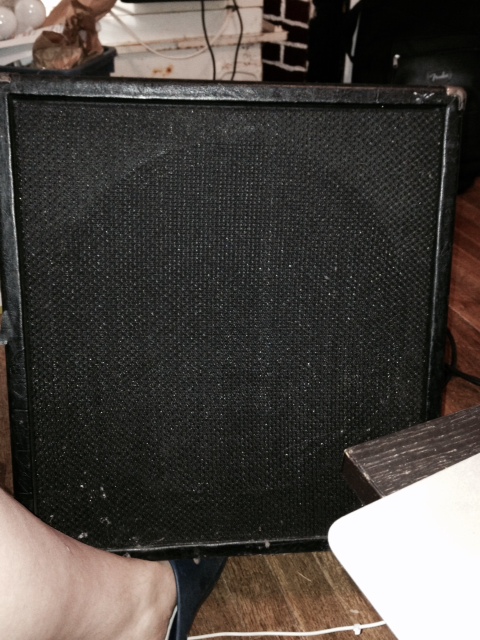
-
I have a chance to pick up a mini- brute III for $60. Lights up, but no sound. I have both the skills and the tools to fix this myself. What typically fails on these?
Any comments on the "III" model? It sounds pretty nice in the youtube clips.
I've been looking to get a small SS amp on the cheap and this seems like a good fit.
-
-
Hey
Buy it ! The reverb, that sucks anyways is failing now and then on Some Amps . Other than that its the common SS amp issues that occurs. Small components that dies. Get it , the best sounding , easiest to play amp u Will ever find. There is a second fuse on the main board inside the amp btw. /H
-

Just change GUITARS to POLYTONE...
Is that good enough enabling ???
-
internal fuse, reverb tank, output trannies, connecting cables between preamp and power amp, special IC chip on pre 86 versions, power amp filters. They have a habit of shorting with headphones inserted.
-
Where is the internal fuse? I can't find it in mine. (I already have the back off.)
-
look at the power amp chassis at the bottom of the cabinet .
there's a fuse holder at the edge of the chassis nearest to you, approximately in the middle, with 2 wires from the amp connecting to each end of the fuse holder.
should have a 7 amp fuse in it
-
-
Been doing some more research and I'm not scared off yet. 
The model I'm looking at is a "III" which doesn't have reverb or distortion.
Looks like this:

Circuit is simple; however, there is an LM391 in the power section that could be a problem to replace if it's bad.
Hopefully and can take a look at it soon.
-
yes, the LM391-80 is very difficult to source. Apparently other versions of the chip with a different suffix are still available, though, and will work
The good news is that this version - looks like the 82 version- is considered by poly lovers to be the best-sounding version. Mine's still going.
I may have the service manual somewhere for this version
-
The III is the version that I have, although mine doesn't have the diamond pattern on the Tolex. I don't see anything indicating the date.
-
a pic might help.
the logos change over time; 90s and later versions had a wire grille and went back to foam grilles only in the last few years; earlier versions have the plain tolex and a logo with no red on the badge.
Unfortunately it's important to try to date them in order to get them fixed, as the circuits change too. The circuits are nothing special, but ( as you can see above) the 80s versions have this special chip that can be hard to find. Also many polytones have special power caps with screw fittings that are also difficult to find in the right values, altho they can be replaced with modern caps with a bit of improvisation ( jazz caps??)
One of the reasons that the earlier amps sound so good is the effect of the thick foam grille in smoothing out the highs IMO
-
Mine has plain tolex, a cloth grille, and no badge (probably got knocked off at some point). "081589" is written in marker on the edge of the chassis, which could be taken to mean August 15, 1989.



-
Judging by the logo on the panel and the grille cloth, looks like a 70s amp.
-
I have a 1982 MB IV with the harlequin covering. It's the same amp as yours with reverb added. Have had a couple of these and found that they all had a label on the front of the power amp with the date penciled in. You can see the label by either removing the speaker or removing the back cover (as you've done in the picture) and using a mirror. (The power amp is the part in the bottom.) I would agree that these are great sounding amps. Haven't had any issues with mine so can't help with how to repair. Good luck!
-
Going to take a look this PM - will report back.
Got a bad case of AAS right now.
-
Done deal! Thanks for " talking me into it".
Here's some quick pics. It's covered in black velvet! Too late to do any testing, but it looks undisturbed inside. Functionality is unknown at this point. Grill is long gone.



-
Got it for $40, since the seller couldn't get it to power up. He assured me that the speaker was good.
Did some testing after replacing the blown fuse with a correct 2A slo blo. Lit up, but nothing but hum. Pretty much what I was expecting. Took out the preamp and power amps. Nothing is burned or has been messed with. It does have the dreaded LM391 chip.
Checked the speaker with another amp and it sounds really nice. The power transistors seem OK, but I need to test them out of circuit. Have a replacement chip on the way from Hong Kong. Should get here within a month....

-
Good luck!
If you can get this working, you scored pretty nicely...i have a 90 ' s MB III...really like it. Loud as hell, clean, with awesome bass response...a great solo guitar gig amp.
-
TECHNICAL POINT
might be worth checking the following, from the '78 service manual:
" Everything seems Ok , but ( power) amp fails to operate:
Check voltage at +ve end of C3. Should be almost up to the +ve supply voltage. If not, current is being drawn out of pin 14 of the IC and the amp is in 'shutdown'. This is caused by a leaky C3 in the delay turn-on circuit"
As you probably know, LM391 -90 and -100 can be substituted for the LM391-80, and they are still available. Poly gave up using this chip in the 80s versions, perhaps because of the reliability problems involved.
-
Thanks a lot for posting that - very helpful. There are a handful of 10uF electrolytic capacitors (including C3) which I plan on replacing.
I plan on adding a heatsink to the LM391. There's a note in the datasheet that it should be derated if operated in environments warmer than 25C/75F. I'm sure the chip gets quite warm inside a sealed cabinet.
I've determined that I have a 1980 model. There is a date written on the preamp chassis and the date codes on the power transistors are 1979.
Thankfully, this is one of the "plain Jane" models w/o reverb or other effects. PC boards look clean and everything is easy to get at.
-
Thanks. PM me with your email address if you could use the service manual.
Good thinking about the temperature issue. I have had my amp blow ( the LM391 and the filter caps) when accidentally left on for a few hours.
-
Fixed!!!!!
Had a bit of free time today. Gave the power amp a good going over and all the transistors and the bridge checked out OK.
I turned my attention to the preamp section, and under the magnifier, I spotted a blown trace. Hmmmmm.

The trace pictured is the signal ground that runs from the final summing stage (preamp output) to the cable that connects to the power section. It ALSO connects to a jack labeled "main output" on the rear of the amp. Great - someone plugged in something they shouldn't have into this jack. I was hoping like hell that the output cap on the final opamp blocked the voltage.
I jumpered the missing trace and slowly brought the amp up with the variac. No more hum and everything was quiet. Plugged in Eastman and out came music. Sounds pretty decent and is very quiet. Liking the tone so far. Probably need a reverb pedal. Up next, building a grill...
Plugged in Eastman and out came music. Sounds pretty decent and is very quiet. Liking the tone so far. Probably need a reverb pedal. Up next, building a grill...
I've posted a short clip. Sorry for the ipad recording, and my apologies to the Replacements. And a big shout out to Franz 1997 for sending me the service manual.
Last edited by Engine Swap; 01-25-2014 at 09:09 PM.
-
I have an early 80's MBIII and want to make sure before I take it to a gig tonight that the "MAIN OUT" on the back of the amp is simply a line out. I tested it and it seems to function as a line out, I just don't want any surprises once I'm at the gig.
-
Far as I know that's right. I've used it as a recording output into a mixer.
-
Thanks Lawson. I tested it with my recording gear and definitely got a signal. What concerned me was the term "main out"---a little odd. 🤔






 Plugged in Eastman and out came music. Sounds pretty decent and is very quiet. Liking the tone so far. Probably need a reverb pedal. Up next, building a grill...
Plugged in Eastman and out came music. Sounds pretty decent and is very quiet. Liking the tone so far. Probably need a reverb pedal. Up next, building a grill...



 Reply With Quote
Reply With Quote



Moving from bedroom to stage...
Today, 08:38 AM in From The Bandstand